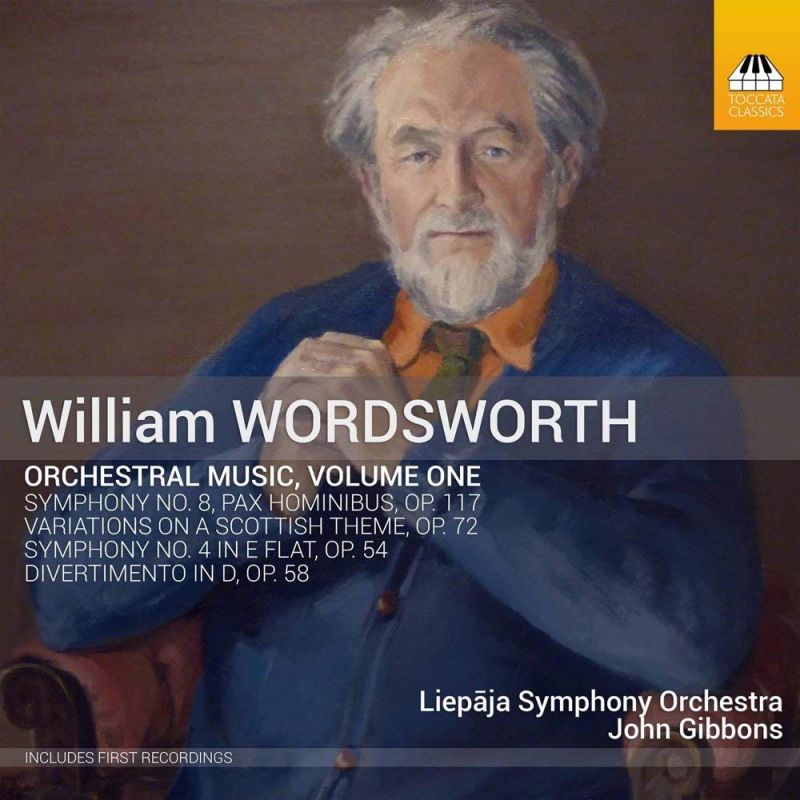WORDSWORTH Orchestral Music No 1
View record and artist detailsRecord and Artist Details
Composer or Director: William (Brocklesby) Wordsworth
Genre:
Orchestral
Label: Toccata Classics
Magazine Review Date: AW18
Media Format: CD or Download
Media Runtime: 81
Mastering:
DDD
Catalogue Number: TOCC0480

Tracks:
| Composition | Artist Credit |
|---|---|
| Divertimento |
William (Brocklesby) Wordsworth, Composer
John Gibbons, Conductor Liepaja Symphony Orchestra William (Brocklesby) Wordsworth, Composer |
| Symphony No 4 |
William (Brocklesby) Wordsworth, Composer
John Gibbons, Conductor Liepaja Symphony Orchestra William (Brocklesby) Wordsworth, Composer |
| Symphony No 8, 'Pax hominibus’ |
William (Brocklesby) Wordsworth, Composer
John Gibbons, Conductor Liepaja Symphony Orchestra William (Brocklesby) Wordsworth, Composer |
| Variations on a Scottish Theme |
William (Brocklesby) Wordsworth, Composer
John Gibbons, Conductor Liepaja Symphony Orchestra William (Brocklesby) Wordsworth, Composer |
Author: Andrew Mellor
That is not necessarily a weakness. Any smiles in the Variations on a Scottish Theme (Wordsworth moved to the highlands in 1961) tend to be introverted, without which these ditties would be mere froth. The single-movement Symphony No 4 ploughs a dark furrow, throwing up a theme that could speak of naive English folksiness but is twisted into something ominous before it can. The music doesn’t take an easy route and delivers an exciting apotheosis, retaining clarity when textures get complicated. Conway’s claims of influence from Carl Nielsen are most evident in the music’s tendency to suddenly flare up with momentary lyricism from an otherwise stringent context.
The comparison with Sibelius puzzles me, however, in music that almost always argues its way sternly rather than unravelling organically. That is most apparent in the Divertimento. Vaughan Williams thought it more of a symphony and it probably contains more in the way of fertile material than the later symphony that follows here. That austere aesthetic again underlines Wordsworth’s skill: counterpoint of rare finesse, excellent part-writing, a rhythmic urgency that feeds the development and this time – in the thrilling third movement – a striking legato trumpet theme à la Shostakovich. Likewise, there’s a certain irony that’s particularly welcome when the same movement almost veers off into a martial style.
Wordsworth was, in fact, a campaigning pacifist, of which his agony-strewn Eighth Symphony speaks. You’d have to agree with Conway that the original ending, a sinking into silence, is the one that makes sense (the cymbal-strewn alternative ending, also included here, surely undermines the message). These are sensitive and at times impassioned performances from Liepāja’s orchestra under John Gibbons. In addition, I would be intrigued to know what the Latvian musicians made of Wordsworth the composer.
Discover the world's largest classical music catalogue with Presto Music.

Gramophone Digital Club
- Digital Edition
- Digital Archive
- Reviews Database
- Full website access
From £8.75 / month
Subscribe
Gramophone Full Club
- Print Edition
- Digital Edition
- Digital Archive
- Reviews Database
- Full website access
From £11.00 / month
Subscribe
If you are a library, university or other organisation that would be interested in an institutional subscription to Gramophone please click here for further information.




